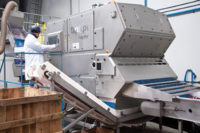If market share numbers are indicative of trade show attendance, 27,000 packaging machinery buyers from food and beverage companies prowled the aisles at the 2012 PACK EXPO event, and they had the kind of checkbook balances that make equipment fabricators’ eyes water.
“US purchasers of equipment seem to be sitting on a lot of money,” noted Tom Egan, vice president-industry services, Packaging Machinery Manufacturers Institute (PMMI), on PACK EXPO’s opening day. Egan’s optimism was based on PMMI’s 2012 Shipments & Outlook Study, an annual survey of equipment machinery sales. The study describes a supplier segment fueled by double-digit growth in customer orders that obliterates the declines in 2008 and 2009.
While the economic recession began in 2007, the effects weren’t felt until late 2008, when a 0.4% decline in machinery shipments occurred. The following year saw a 16.3% drop in orders, but the segment roared back in 2010, with a 31% sales gain followed by 19.3% in 2011. According to Egan, machine purchases remained strong through 2012’s first three quarters, with continued strength projected through 2013.
Food and beverage manufacturers account for three-fifths of the market, dwarfing all other segments (pharmaceutical packagers are the next largest segment, at 8 percent). Machinery purchases by food and beverage firms increased 17 percent in 2011 to $5.3 billion. However, production growth of 2.2 percent in prepared foods and 3.9 percent in beverages, including coffee and tea, will slow in 2013 before declines of 5.1 percent in beverages and 0.2 percent in food in 2014, according to PMMI’s forecast.
Still, implementation of the Food Safety Modernization Act (FSMA) will force food and beverage manufacturers to buy new packaging equipment, Egan predicts. “Companies are beginning to game plan for FSMA, particularly in baking and snack, where they are moving from visually clean to microbiologically clean requirements,” he says. “There’s no provision in FSMA for a grandfather exemption. All areas, including packaging, will have to be brought into compliance.”
The trade deficit in packaging machinery grew to $1.1 billion in 2011, with foreign firms selling $1.8 billion worth of equipment to US manufacturers compared to $686 million in overseas shipments by US firms. Part of the deficit reflects the growing use of pouches and other flexible packages. European equipment companies have catered to flexible applications for decades. Consequently, there “is a perception” their machinery is superior, Egan concedes. However, any advantages have been erased by American ingenuity, he adds, and domestic machine builders will benefit from the growing demand for pouch packages, particularly for food, where half of surveyed companies say they will increase their use of flexible packages.




